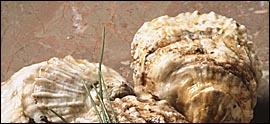Oysters’ gills trap fine sediment, package it in mucus, and then dispose of it
on the bottom, where it becomes part of the food web. The mollusk’s primary food
is phytoplankton (algae). By grazing on these microscopic, single-celled plants,
oysters help rid the Chesapeake of another nuisance. Algae cloud the water, shading
it so much that underwater "Bay grasses" can’t grow. When the uneaten algae die,
they sink to the bottom, where the process of decay takes huge amounts of dissolved
oxygen out of the water, sometimes making it uninhabitable for fish, crabs, and even
oysters. Because algae thrive on pollutants such as stormwater runoff and wastewater
discharge, the oyster’s decline has made it doubly difficult for the Bay to cleanse
itself.
|
Like their more-colorful counterpart, the coral reef, the Bay’s grayish oyster reefs
(known as "rocks") provide a live bottom habitat for fish and other aquatic life. Rocks
are rich living communities of tiny fixed creatures (such as anemones, barnacles, and
sponges) that attract scavengers (such as grass shrimp, sea worms, mud crabs, and blue
crabs). The scavengers, in turn, bring in small fish, which lure larger sportfish and,
of course, anglers.
|
